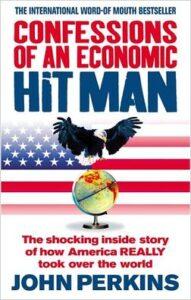Book Summary: Confessions of an Economic Hitman by John Perkins
Buy the book: Print | Ebook | Audiobook
Or, browse more book summaries
The Book in Three Sentences
“Confessions of an Economic Hitman” is a book written by John Perkins, a former economic hitman who worked for a US consulting firm. In the book, Perkins describes how he and others like him used economic and political strategies to manipulate developing countries and exploit their resources for the benefit of corporations and governments. He also shares his personal journey of realizing the negative impact of his actions and becoming an advocate for positive change.
Book Summary
Confessions of an Economic Hit Man by John Perkins provides a revealing, first-person account of the economic and political strategies that powerful corporations and governments use to manipulate developing nations.
Perkins, a former chief economist for an international consulting firm, shares his experiences working as an “economic hit man” (EHM), a role in which he claims to have been part of a global effort to secure the interests of U.S. corporate and government power.
The book combines elements of memoir, political commentary, and economic theory, offering insight into the covert operations and systemic abuses that Perkins argues form a hidden aspect of global capitalism.
Introduction: Understanding the Economic Hit Man
The term “economic hit man” (EHM), as Perkins explains, refers to a professional whose main job is to convince leaders of underdeveloped or developing countries to accept substantial loans for large infrastructure projects (often from the World Bank or the International Monetary Fund).
These loans, rather than benefiting the countries, often saddle them with crushing debt while enabling the United States to exert significant influence and control over them. Perkins contends that EHMs work behind the scenes to further the agenda of a “corporatocracy” – a coalition of powerful interests involving corporations, governments, and international organizations.
Chapter Summaries
1. The Making of an Economic Hit Man
Perkins begins with an account of his journey from a modest upbringing to becoming an influential figure in global finance. He describes his time at Boston University, where he was introduced to the broader economic theories that would later inform his work.
Upon graduation, he joined the National Security Agency, which recommended him for a position at the private consulting firm Chas T. Main. This firm had contracts with the U.S. government to promote infrastructure projects abroad, particularly in developing countries. Perkins received targeted training in economic forecasting, especially on methods to inflate economic projections.
The chapter highlights his transition from an idealistic graduate to a “hit man,” with his initial job to convince countries to take on large loans based on his inflated projections. He describes feeling conflicted, knowing his actions could harm these countries, but he was enticed by the rewards, status, and power that came with the job.
2. Global Empire Building
In this chapter, Perkins discusses how EHMs are part of a larger, calculated system of what he describes as “corporate imperialism.” He explains that the goal of EHMs isn’t merely to build infrastructure but to trap countries in debt they can never repay, effectively turning them into economic colonies.
Perkins describes how projects such as hydroelectric dams, airports, and power plants would be proposed to leaders of developing nations, often pitched as a route to modernization and prosperity. In reality, these projects benefitted only a small elite, leaving the majority of the population further impoverished. Perkins describes specific tactics, like overestimating the economic benefits of a project while understating potential costs.
As a result, countries would agree to loans they couldn’t afford, with the money funneled back to U.S. corporations under the guise of “development assistance.” He explains how debt dependency allowed the U.S. to demand political favors and economic policies favorable to American interests.
3. The Reality of Economic Imperialism
This chapter delves into the long-term impacts of debt dependency and economic imperialism, illustrating how developing nations are manipulated to serve the interests of the U.S. and its corporations. Perkins explains how indebted countries are forced to cut public services, devalue their currency, and privatize resources, which leads to increased poverty and inequality.
He describes several examples, including countries in Latin America, Africa, and Southeast Asia, where EHMs and American corporations influenced leaders to adopt policies that undermined their national interests. Perkins details his encounters with officials who realized the exploitative nature of these agreements but felt powerless against the United States’ overwhelming political and economic leverage.
This chapter also discusses the idea of “structural adjustments” imposed by the International Monetary Fund (IMF) and the World Bank, which required countries to adopt austerity measures that further impoverished their populations.
4. Case Study: Ecuador and Panama
Perkins recounts specific assignments in Ecuador and Panama that exemplify how EHMs operate. In Ecuador, Perkins was responsible for inflating GDP projections to justify a massive loan that funded infrastructure projects primarily benefiting American contractors. As the loans burdened Ecuador with debt, it became increasingly dependent on U.S. aid and influence.
Perkins details how Ecuadorian leaders struggled to resist pressure to allocate resources toward loan repayments instead of public needs. In Panama, Perkins was assigned to work with the controversial yet popular leader Omar Torrijos, who opposed U.S. influence and sought to reclaim the Panama Canal for his country. Perkins notes that Torrijos’s resistance to economic manipulation, including his refusal to take certain loans, made him a target of the corporatocracy.
He highlights Torrijos’s mysterious death in a plane crash, raising questions about U.S. involvement in the deaths of foreign leaders who oppose American interests.
5. The Tactics of the Corporatocracy
In this chapter, Perkins goes in-depth into the “corporatocracy” and how it operates, describing it as a coalition of corporate, governmental, and banking interests that use various tactics to maintain control over other countries.
EHMs, according to Perkins, are only one part of this system, with “jackals” – covert operatives from agencies like the CIA – deployed when EHMs fail to sway leaders. If even the jackals fail, the U.S. government may intervene militarily. Perkins provides several examples where the corporatocracy worked to overthrow or assassinate leaders who refused to cooperate with U.S. interests, including Jacobo Árbenz in Guatemala and Mohammad Mossadegh in Iran.
This chapter highlights how the corporatocracy uses propaganda, covert action, and economic pressure to remove obstacles to American interests. Perkins describes this system as a “shadow empire,” one where open conflict is rarely necessary because financial and political manipulation achieves the same results with less resistance.
6. Iraq and the Roots of Modern Economic Conflict
This chapter focuses on the Middle East, specifically Iraq, as a significant example of where economic manipulation failed, resulting in a military conflict. Perkins discusses the complex relationships between Iraq, the U.S., and other major powers, including the importance of oil as a primary resource of interest.
He details attempts by EHMs to persuade Saddam Hussein to align Iraq with U.S. economic and political policies, which Hussein repeatedly resisted. According to Perkins, this resistance played a role in the U.S. decision to wage the Gulf War in the early 1990s and subsequent conflicts in the region. He suggests that these wars are part of a broader strategy to control oil-rich regions by ensuring that Middle Eastern leaders remain dependent on American support.
Perkins contends that war is the last resort when financial and political coercion fails, and he points to Iraq as a prime example of how American foreign policy can shift from economic manipulation to outright military intervention when national interests are at stake.
7. Reflection on Accountability and Change
After detailing his work and its consequences, Perkins reflects on the ethical dimensions of his career as an EHM, addressing the personal guilt and regret that ultimately led him to leave the profession and speak out.
He expresses his realization that, although he was part of a powerful and influential system, it was one that operated at the expense of millions of people who suffered because of the policies he helped implement.
Perkins admits that he was initially drawn to the financial rewards and prestige of his role, but as he began to see the long-term damage inflicted on the nations he targeted, he became increasingly uncomfortable.
The chapter serves as a moral reckoning, where Perkins acknowledges his complicity and encourages readers to understand the real-world impact of economic manipulation on ordinary people. This introspective chapter is also a critique of the corporate and political forces that continue to drive this system of exploitation.
8. A Call to Action
The final chapter is a plea for reform and resistance against the corporatocracy, advocating for a shift toward more sustainable and ethical approaches to global development.
Perkins urges readers to become aware of the hidden costs of corporate-driven globalization and to challenge the institutions and practices that perpetuate inequality and environmental degradation. He highlights the need for accountability, transparency, and policies that prioritize people over profits. Perkins calls on readers to support fair-trade initiatives, ethical businesses, and leaders committed to social justice.
He believes that change is possible if individuals and communities reject consumerism and advocate for economic systems that respect cultural diversity and protect the environment. Perkins ends the book with a message of hope, encouraging people to recognize the power they have to make a difference and to take action against the forces of economic imperialism.
Key Themes
The Role of Corporatocracy: Perkins describes the corporatocracy as a group of elite corporations, banks, and governments working together to maintain control over global resources and economies, using financial manipulation as a modern form of imperialism.
Economic Imperialism: The book explores how countries are kept in a cycle of debt that makes them dependent on the U.S., a process Perkins describes as a form of economic imperialism that serves the interests of the few at the expense of the many.
Environmental and Social Impacts: Perkins discusses the environmental degradation and social inequality that accompany many of these projects. Indigenous lands and cultures are often threatened, and the environment suffers due to exploitation and unsustainable practices.
The Moral Quandary of an Economic Hit Man: Perkins grapples with his own role in perpetuating this system, providing readers with a personal account of the moral compromises and eventual disillusionment that led him to write the book.
Resistance and Hope for Change: Perkins encourages resistance against corporate control and suggests that people have the power to change the system by supporting ethical businesses, lobbying for policy changes, and holding corporations accountable for their actions.
Conclusion
Confessions of an Economic Hit Man is a powerful critique of modern capitalism’s global reach and its impact on developing countries. Through his personal experiences, John Perkins illustrates how powerful economic interests shape world events and manipulate leaders, often at the cost of democracy, social justice, and environmental health.
The book serves as both a memoir and a manifesto, urging readers to be aware of the hidden costs of global capitalism and to work toward more just and sustainable economic systems.
Important quotes










About Author of "Atomic Habits"
John Perkins is an American author, activist, and former economic consultant, best known for his work Confessions of an Economic Hit Man. Born on January 28, 1945, Perkins grew up in a modest family in New Hampshire. He attended Boston University, where he studied economics and business administration before joining the Peace Corps. In his writing and public speaking, Perkins often describes his journey from a bright-eyed young professional to an insider in what he calls the “corporatocracy,” a coalition of corporate, financial, and governmental interests that, he argues, manipulates global economics to serve its own agenda.
In the 1970s, Perkins joined the international consulting firm Chas T. Main, where he became a self-described “economic hit man” (EHM). In this role, Perkins claims he was tasked with persuading leaders of developing nations to accept enormous loans for infrastructure projects—loans that these nations often couldn’t afford. The projects, financed through entities like the World Bank and the International Monetary Fund, were designed to benefit American corporations and ensure ongoing control over the countries’ resources and policies. Over time, Perkins grew disillusioned with this work, concerned about its exploitative impact on impoverished nations.
Since leaving his corporate role, Perkins has dedicated his career to exposing what he sees as the dark side of global capitalism. Through books, lectures, and activism, he discusses the environmental, economic, and social consequences of unregulated corporate power. Perkins’ follow-up books, including The Secret History of the American Empire and Hoodwinked, continue to explore the themes of economic imperialism and advocate for reform. Today, he speaks widely on topics like ethical business practices, sustainability, and the need for global economic reform.

